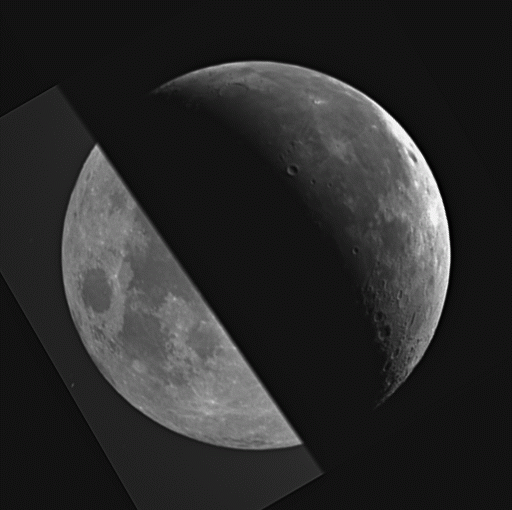October 7, 2017
Monitoring Earthshine
Originally published March 27, 2008

image by Project Earthshine (this image is mirror reversed; east is on the left)
Among the most dedicated, but perhaps least known, of the modern lunar observers are those monitoring the Moon's ashen light. The changing amounts of the incident sunlight that are reflected into space by the Earth has an obvious and very direct impact on our planet's energy balance, and the Moon provides a surprsingly simple way to monitor that. Since December 1998, every clear night, from moonrise to moonset, automated telescopes at the Big Bear Solar Observatory (in Southern California), and other stations of the growing Project Earthshine network, record images similar to that shown above. On the right we see the normal crescent of a waning Moon; and on the left a piece of the ghostly surface splashed by sunlight reflected from the Earth. Because we are always standing with the source of this light directly to our backs, this varying component of the Moon's illumination has the appearance of a faint, but perpetual, Full Moon. Normally our eyes would be dazzled by the bright crescent, and we would have difficulty seeing the much fainter ashen light, but a filter placed over the sunlit side makes the two look of similar intensity. In each image, scientists monitor the intensity in a pair of diametrically-opposite highland areas selected from sets of five each near Grimaldi on the west, and Mare Crisium on the right, as well as the integrated intensity of the sunlit crescent as a whole. Inevitable changes in the sky's transparency vary the overall brightness of the image, but the comparison of the two sides corrects for this and reveals whether the Earth is reflecting more or less than "normal" (compared to the directly incident sunlight) for this phase (as seen from the Moon, the Earth goes through phases mirroring those we see on the Moon). Because the intensity of the earthshine seen by an observer at a particular point on the Earth's dark side is always determined by features far away on the sunlit side, getting an accurate picture of the reflectance of the Earth as a whole requires a network of nighttime observing stations positioned at a variety of longitudes. From the data obtained so far, Project Earthshine scientists have learned that the intensity of the earthshine fluctuates by about 5% over periods of a few hours as different landforms rotate into the sunlit area visible from the Moon, and that the intensity seen in a given configuration in different months varies by about the same amount due to seasonal and weather changes. Whether there are any long-term changes taking place will, of course, take a long time to determine.
Jim Mosher
Technical Details
Cover image from Science magazine; date unknown; 6-inch refractor with cooled AP-7 512x512 pixel CCD camera; right side of image attenuated 10,000X by filter in focal plane; fiducial areas are 10 pixels on a side. The technique used in Project Earthshine is a modernized adaptation of a visual method developed by the French scientist André Danjon in the 1920's.
Related Links
Unfortunately, the Project Earthshine website is not very up-to-date, but the team has left an impressive legacy of publications including the following (and more):
- Montañés-Rodríguez, Pilar; Pallé, Enric; Goode, P. R. Measurements of the Surface Brightness of the Earthshine with Applications to Calibrate Lunar Flashes. The Astronomical Journal, Volume 134, pp. 1145-1149 (2007).
- Montañés-Rodriguez, P.; Pallé, E.; Goode, P. R.; Hickey, J.; Koonin, S. E. Globally Integrated Measurements of the Earth's Visible Spectral Albedo. The Astrophysical Journal, Volume 629, pp. 1175-1182 (2005).
- Pallé, E.; Goode, P. R.; Montañés-Rodriguez, P.; Koonin, S. E.; Rumyantsev, V. Toward a global earthshine network: First results from two stations. Geophysical Research Letters, Volume 32, Issue 11, CiteID L11803 (2005).
- Pallé, E.; Goode, P. R.; Montañés-Rodríguez, P.; Koonin, S. E. Changes in Earth's Reflectance over the Past Two Decades. Science, Volume 304, pp. 1299-1301 (2004).
- Pallé, E.; Montañés Rodriguez, P.; Goode, P. R.; Qiu, J.; Yurchyshyn, V.; Hickey, J.; Chu, M.-C.; Kolbe, E.; Brown, C. T.; Koonin, S. E. The Earthshine Project: update on photometric and spectroscopic measurements. Advances in Space Research, Volume 34, pp. 288-292 (2004).
- Qiu, J.; Goode, P. R.; Pallé, E.; Yurchyshyn, V.; Hickey, J.; Montañés Rodriguez, P.; Chu, M.-C.; Kolbe, E.; Brown, C. T.; Koonin, S. E. Earthshine and the Earth's albedo: 1. Earthshine observations and measurements of the lunar phase function for accurate measurements of the Earth's Bond albedo. Journal of Geophysical Research, Volume 108, Issue D22, pp. ACL 12-1, CiteID 4709 (2003).
- Goode, P. R.; Qiu, J.; Yurchyshyn, V.; Hickey, J.; Chu, M.-C.; Kolbe, E.; Brown, C. T.; Koonin, S. E. Earthshine observations of the earth's reflectance. Geophysical Research Letters, Volume 28, pp. 1671-1674 (2001).
Note: this LPOD was contributed by a Wikispaces member while Chuck Wood was attending the March 2008 Lunar & Planetary Science Conference.
Yesterday's LPOD: Domed Donut
Tomorrow's LPOD: Not What You Think
COMMENTS
COMMENTS?
Register, Log in, and join in the comments.



